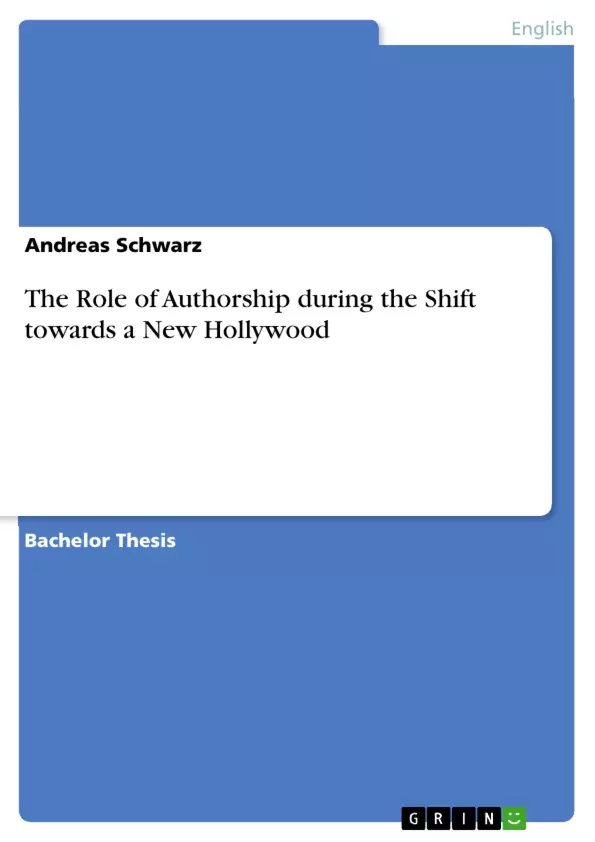In film studies, the term New Hollywood is used in non-conclusive and heterogeneous ways. The discourse does not make explicit what the real New was. However, there appears to be a general consensus as to the actual time frame in which a bigger change happened in Hollywood that stirred up the system – starting in 1967. Scholars have been trying to explain the proclaimed change of the Classical Hollywood Cinema from different perspectives, which, depending on author and release date, point out economical, production-related, societal, or creative-aesthetic revolutions as responsible factors.
Coming from the film critic‘s angle towards New Hollywood, the most important factor in the process was the development and success of the American auteur. The auteur theory has been appointed as such by film critic Andrew Sarris, who based his assumptions mainly on the theoretical conclusions drawn by the writers of the French Cahiers du Cinema. Taking the auteur approach to explain aspects of the New Hollywood, some scholars pinpoint the era down to the years of 1967-1976. This national cinematography is hardly discussed consensually within its own historiographical discourse or the boundaries of text analysis. I want to specifically trace the role of the idea of an auteur cinema within the Hollywood industry during this change, and thereby further disentangle the complex relationship of commerce and authorship.
My first chapter will therefore be employed with the theoretical background and the discourse around authorship in general, film in particular. Eventually this will lead to a clear idea about the specifics and limitations of the auteur theory discourse. The second chapter will then be occupied with the historical change of the Hollywood system in the sixties and seventies of the twentieth century, and will aim to define the contributing factors for this change within and outside the industry. In terms of terminology, a historiographical approach will determine the rather different meanings of New Hollywood and Hollywood Renaissance. Chapter three will tie up the loose ends of both previous chapters, striving to identify what kind of influence on film production the auteurs of New Hollywood had in terms of the reinvigorated success of the American film industry or if they were auteurs at all for that matter. What room is there in a system which is based on its own myths of star power etc. for the serious artistic vision of the individual?
Inhaltsverzeichnis (Table of Contents)
- Introduction
- The concept of authorship and the auteur theory.
- The discourse of authorship in texts.
- Authorship in film
- Auteur theory.
- The Hollywood system - collapse and reinvention
- Classic Hollywood.............
- Changes within and outside the Hollywood system ......
- Economy and aesthetic – what is the New Hollywood?
- Authorship and the Hollywood Renaissance.
- Auteur theory applied to the Hollywood Renaissance.
- Authorship and industrial success
- Conclusion
Zielsetzung und Themenschwerpunkte (Objectives and Key Themes)
This thesis examines the role of authorship in the context of the New Hollywood era, particularly the "Hollywood Renaissance" of the late 1960s and early 1970s. It investigates how the concept of the auteur, popularized by the French Cahiers du Cinéma, intersected with the changing Hollywood system and its economic and aesthetic reinvention.- The historical development and theoretical complexities of authorship in film, specifically the auteur theory.
- The transformations within the Hollywood system during the 1960s and 1970s, leading to the emergence of the New Hollywood.
- The influence of auteurism on the Hollywood Renaissance, exploring the interplay of commercial success and artistic vision.
- The application of auteur theory to the works of prominent filmmakers of the New Hollywood era.
- The complex relationship between authorship, industry structures, and the development of a national cinema.
Zusammenfassung der Kapitel (Chapter Summaries)
The first chapter delves into the theoretical framework of authorship, analyzing the discourse surrounding the concept of authorship in texts and its application to film. This chapter focuses on the development of auteur theory, outlining its key concepts and its influence on film criticism. The second chapter examines the historical evolution of the Hollywood system, highlighting the changes that occurred during the 1960s and 1970s, leading to the emergence of the New Hollywood. This chapter explores the economic, production-related, societal, and creative-aesthetic factors that contributed to this shift. The third chapter explores the relationship between authorship and the Hollywood Renaissance. This chapter analyzes how the auteur theory influenced the works of prominent filmmakers during this era and examines the impact of auteurism on the American film industry's success.Schlüsselwörter (Keywords)
The thesis centers on the interplay of authorship, film theory, and the evolution of the Hollywood system. It delves into the concepts of auteurism, New Hollywood, Hollywood Renaissance, and the impact of commercial success on the creative expression of filmmakers. The work also touches upon important themes such as the relationship between industry structures and artistic vision, the role of film criticism, and the evolution of a national cinema.- Quote paper
- Andreas Schwarz (Author), 2011, The Role of Authorship during the Shift towards a New Hollywood, Munich, GRIN Verlag, https://www.grin.com/document/184934



